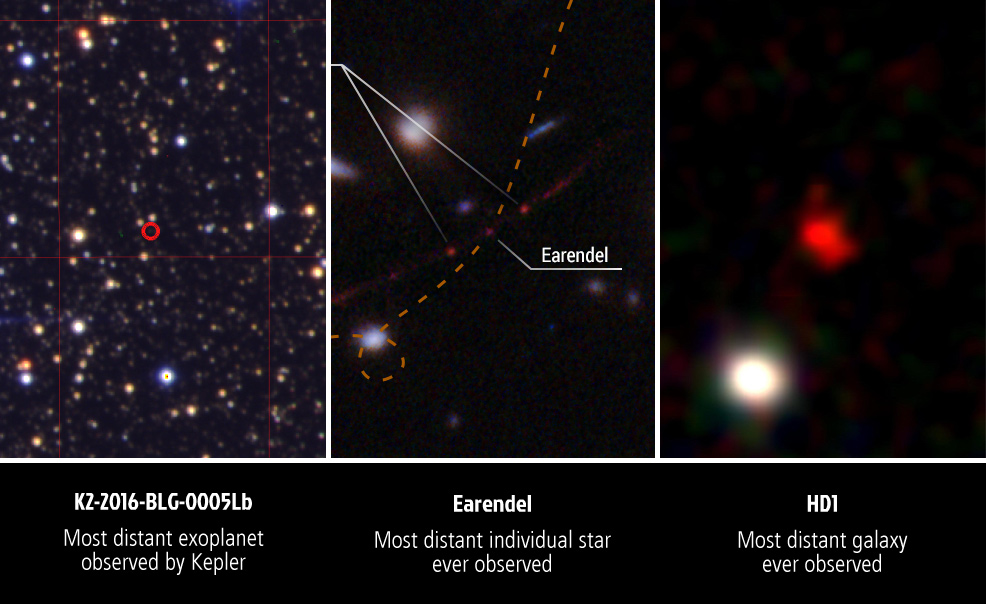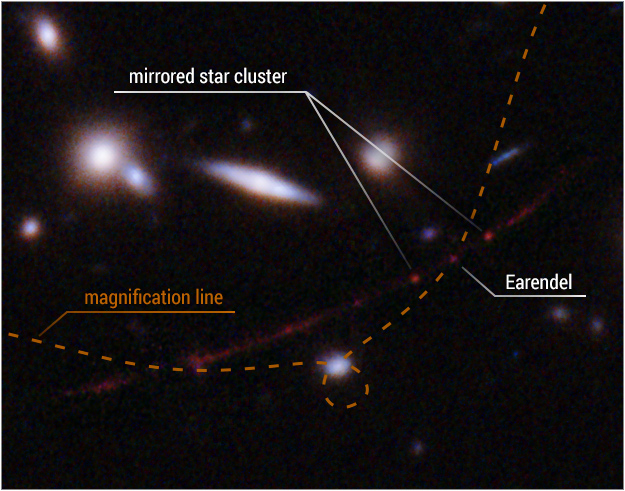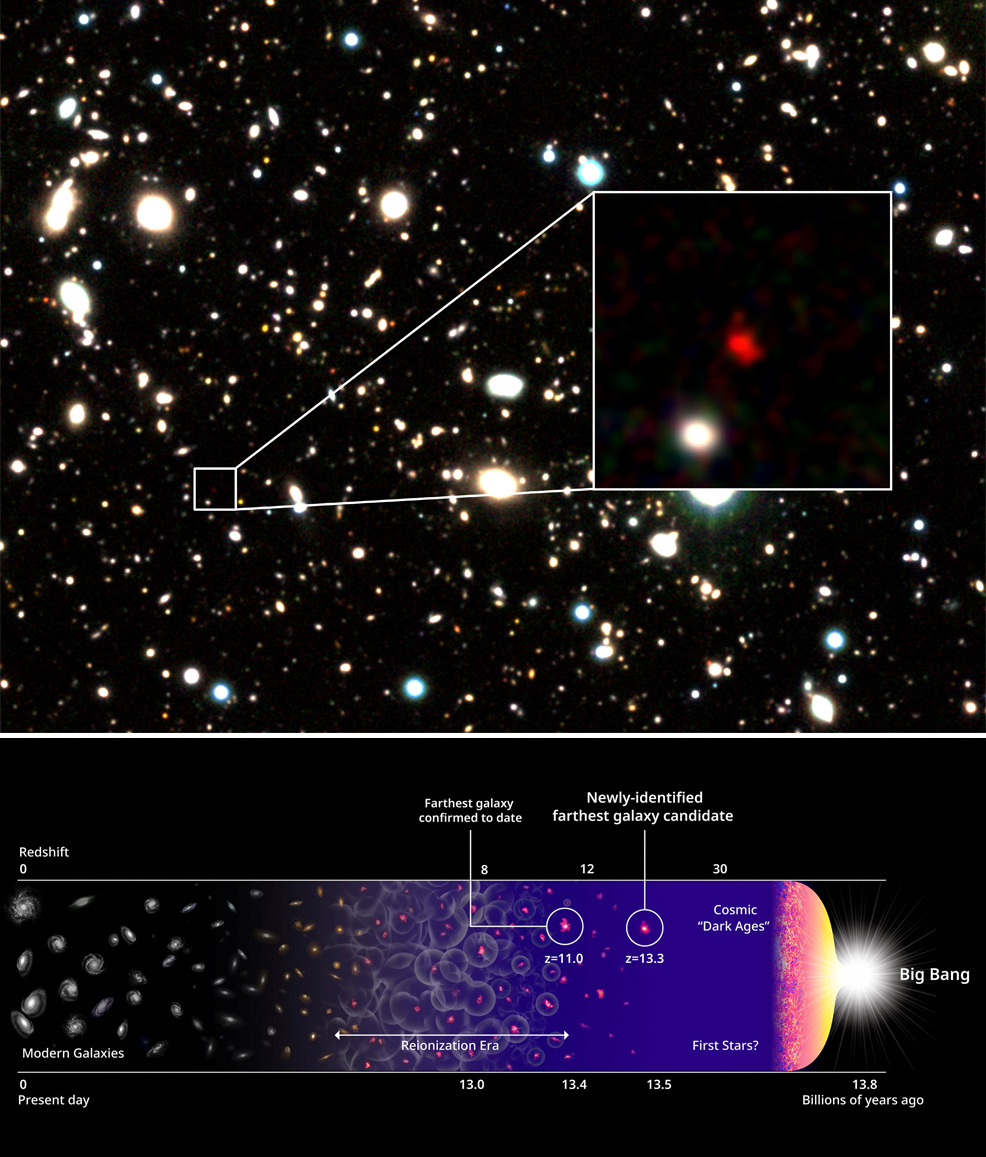
11th April 2022 New records for most distant planet, star, galaxy The most distant exoplanet discovered by the Kepler Space Telescope (17,000 ly), the most distant individual star (12.9 billion ly), and the most distant galaxy ever seen (13.5 billion ly) have all been reported.
This is proving to be an eventful month for astronomy, with a string of discoveries setting new distance records. These could undergo follow-up observations by the James Webb Space Telescope and other forthcoming projects. Although NASA retired the Kepler Space Telescope in 2018, researchers continue to analyse the data it generated. The tally of confirmed exoplanets passed the 5,000 milestone last month and Kepler discovered 2,709 (about 54%) of those. This month, a team at the University of Manchester, United Kingdom, reports that a new planet has emerged from data collected in mid-2016, when Kepler monitored stars around the galactic core. This world is located 17,000 light years away – twice the distance of its previous record. Until now, Kepler's detections used the transit method, which takes advantage of the periodic dimming caused by exoplanets that cross in front of their host star. Only planets whose orbits are edge-on from Earth can be detected in this way. However, the University of Manchester team employed a technique called gravitational microlensing, in which light from a background object is bent by gravity around a foreground object, acting like a giant magnifying glass. The effect can be seen in the video animation below. The planet – known as K2-2016-BLG-0005Lb – is almost identical to Jupiter in terms of its mass and orbit within the system. Its host star has a mass about 60% that of our Sun. Five international ground-based surveys also looked at the same area of sky at the same time. The difference in vantage point between Kepler and the observatories on Earth allowed the researchers to triangulate the system's exact location. They exhaustively modelled the combined datasets showing, conclusively, that the signal is caused by a very distant exoplanet. While even more remote exoplanets have been discovered by other telescopes (the current record is 27,710 ly and the first extragalactic candidate has recently been announced), this new world is the farthest yet seen by Kepler, specifically. A paper describing this work has been submitted to the Monthly Notices of the Royal Astronomical Society, and is available on the preprint server arXiv.
In a separate study, astronomers have reported the most distant individual star ever observed. This time, a team using the Hubble Space Telescope (HST) made the discovery, which appears in the journal Nature. The newly found star – WHL0137-LS, also known as Earendel – is so far away that its light has taken 12.9 billion years to reach Earth, appearing to us as it did when the Universe was just 7% of its current age. This has smashed the previous record, held by a star called Icarus, the light from which took "only" 9.3 billion years to reach us. The galaxy hosting this star has been magnified and distorted by gravitational lensing into a long crescent, which the scientists involved in this study named the Sunrise Arc. Following a detailed analysis of this galaxy, they determined that one feature is an extremely magnified star, now called Earendel, which means "morning star" in Old English. The research team estimates that Earendel is at least 50 times our Sun's mass and millions of times brighter, rivalling the most massive stars known. But even such a brilliant, very high-mass star would be impossible to see at such a great distance without the aid of natural magnification by a huge galaxy cluster, WHL0137-08, sitting between us and Earendel. The mass of the galaxy cluster warps the fabric of space, creating a powerful natural magnifying glass that distorts and greatly amplifies the light from distant objects behind it. Thanks to a rare alignment with the magnifying galaxy cluster, Earendel appears directly on, or extremely close to, a ripple in the fabric of space. This ripple provides maximum magnification and brightening. The effect is analogous to the rippled surface of a swimming pool creating patterns of bright light on the bottom of the pool on a sunny day. The ripples on the surface act as lenses and focus sunlight to maximum brightness on the pool floor. This causes the star to pop out from the general glow of its home galaxy, magnifying its brightness a thousandfold or more. Astronomers expect that Earendel will remain highly magnified for years to come. It will be observed by NASA's James Webb Space Telescope. Webb's high sensitivity to infrared light is needed to learn more about Earendel, because its light is stretched (redshifted) to longer infrared wavelengths, due to the expansion of the Universe. Earendel's composition will be of great interest to astronomers, because it formed before the Universe was filled with heavy elements produced by successive generations of massive stars. If follow-up studies find that Earendel consists of only primordial hydrogen and helium, it would be the first evidence for the legendary Population III stars, which are hypothesised to be the very first stars born after the Big Bang. "With Webb, we may see stars even farther than Earendel, which would be incredibly exciting," said Brian Welch, a PhD student at Johns Hopkins University and lead author of the study. "We'll go as far back as we can. I would love to see Webb break Earendel's distance record."
The third and final discovery this month is the most distant known galaxy. An international team – which included researchers from the University of Tokyo, Waseda University, and the Harvard-Smithsonian Center for Astrophysics – announced details of a candidate they have named HD1. It has a neighbour that is almost as far away, called HD2. By a significant margin, these are the earliest and most distant galaxies ever identified in the observable Universe. HD1's redshift is 13.3, which means that light from the galaxy travelled for 13.5 billion years on its way towards Earth. But because of the Universe's expansion since then, its proper distance now is actually 33.4 billion light years. We can observe HD1, a faint red smudge in the image below, as it appeared just 330 million years after the Big Bang. That is 90 million years further back than the previous record holder – GN-z11, which has a redshift of 11. The research team sifted through more than 1,200 hours of observation data taken by the Subaru Telescope, VISTA Telescope, UK Infrared Telescope, and the Spitzer Space Telescope. HD1 emerged from analysis of more than 700,000 objects. Its red colour matched the expected characteristics of a galaxy at a distance of 13.5 billion light years. They then conducted follow-up observations using the Atacama Large Millimeter/submillimeter Array (ALMA) – the world's most powerful radio telescope – to confirm its location. This also revealed a weak signal at the frequency where an oxygen emission line was expected. HD1 is very bright, suggesting that bright objects already existed when the Universe was just 2% of its current age. Observational information is limited, and its physical properties remain a mystery, but HD1 is thought to be a very active star-forming galaxy. So active, in fact, that the researchers' calculations suggest it could be forming over 100 stars every single year. The team at Harvard-Smithsonian describe this as "an incredible rate [...] at least 10 times higher than what we expect for these galaxies." "The very first population of stars that formed in the Universe were more massive, more luminous and hotter than modern stars," explains Fabio Pacucci, PhD, study co-author. "If we assume the stars produced in HD1 are these first, or Population III, stars, then its properties could be explained more easily. In fact, Population III stars are capable of producing more UV light than normal stars, which could clarify the extreme ultraviolet luminosity of HD1." A supermassive black hole within HD1 could also explain its extreme luminosity. As it consumes enormous quantities of gas, high energy photons may be emitted by the region around the black hole. If that is proved by subsequent observations, it would be the earliest supermassive black hole by far, much closer in time to the Big Bang compared to the current record holder. Like the exoplanet K2-2016-BLG-0005Lb and the star Earendel, both HD1 and its neighbour will be a target for the James Webb Space Telescope as well as the Nancy Grace Roman Space Telescope planned for launch in 2027. According to the researchers, these next-generation observatories could help discover a further 10,000 galaxies at this very early epoch of the Universe.
Comments »
If you enjoyed this article, please consider sharing it:
|









